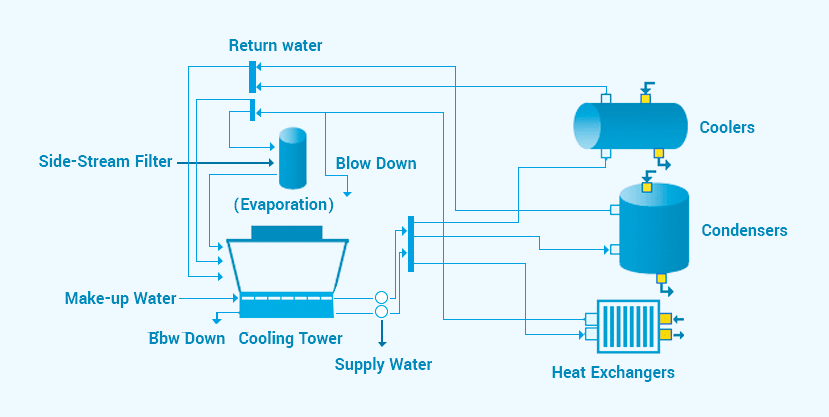Cooling towers are one of the essential parts of any industry for some cooling and to improve its performance, long equipment service life and efficient process some cooling tower water treatment is required. On the other hand, if untreated water is used for cooling towers the risk of fouling, organic growth, corrosion and scaling will increase. It will also affect the other factors like reduce plant productivity, require costly equipment replacement and case plant downtime.
That is why today we will discuss what cooling tower water treatment is and how does it work?
What is cooling tower water treatment?
A cooling tower water treatment is using technologies which remove the damaging and excessive impurities from the cooling tower feed water, blowdown and circulation water.
Before starting the treatment, several tests are conducted to determine the condition of water and which treatment is suitable for cooling tower water treatment.
What factors are controlled by the cooling tower water treatment?

Cooling tower water treatments control the following factors of water:
• Alkaline level: it dictates potential of scales of calcium carbonate
• Chlorides: it causes the corrosion of metals, depending on the type of metals used in the cooling tower and other equipment, the level of chloride is determined, to reduce the rusting and other corrosives.
• Hardness: it causes the formation of scales on heat exchangers and cooling towers.
• Irons: the iron can foul the equipment when combined with phosphate.
• Organic matter: the organic growth which is present in water can lead to microorganism growth leading to fouling, other system issues and corrosion.
• Silica: it is famous for forming hard scale despot
• Sulfates: it can increase the corrosion of metals including chlorides.
• TDS – total dissolved solids: it is responsible for corrosion, foaming and scaling
• TSS – total suspended solid: it is responsible for undissolved contamination which causes biofilm, scaling and corrosion.
How does cooling tower water treatment work?
Every process varies from each other depending on the condition of water, the requirement of the cooling tower and other factors of circulation and feed water. But, mostly following steps are included in the cooling tower treatment system:
1. Makeup water intake of cooling tower:
The water which is evaporated and bleed from the source is collected it can be raw water, city-treated water, city water, well water, in-plant wastewater recycle or any surface water source.
On this point, the water is analyzed and its quality to determine that any treatment is required or not. Is the water treatment is needed at this point of cooling tower water treatment, the technology requires to remove the silica and hardness as well as adjust the pH level.
Here, the process requires to treat the optimize the tower evaporation cycle and minimize the bleed rate of water which can be done with the chemicals alone.
2. Ultrafiltration and filtration:
The water usually contains suspended particles like any organic matter, turbidity or sediments. That is why filtration is required to remove at this stage which helps in removing the suspended solids up steams which helps in protecting the membranes and ion exchange. These issues can later cause the fouling that is why depending on the type of filtration the suspended particles are removed from the water.
3. Water softening/ ion exchange:
Now once the suspension is removed from the water, it is time to treat the hardness. There can be many methods used to exchange the ions such as electronic water conditioners which changes the ion of calcium and magnesium with ions of sodium and potassium. Other methods can also be used here like using strong acid for cation exchange procedure. During this process, the resin is charged with sodium ion and the hardness comes through it. It grabs the higher affinity of magnesium, calcium and iron molecules and releases the sodium molecules in water. If these minerals and contaminations are present in the water will cause the rust and scale deposit.
4. Addition of chemicals:
At this stage of the process the chemicals are used like:
• Corrosion inhibitors like bicarbonates to protect the metal components and neutralize the acidity.
• Biocides and Algaecides like bromine is used to prevent the growth of biofilms and microbes
• Scale inhibitors like phosphoric acid are used for formation of scale deposits and contaminants.
At this stage, the quality of water is determined to select which is the best method to treat the cooling tower water which depends on the condition of the water. Also, using chemical treatments can be much expensive and other treatments like electronic water conditioner are much cheaper.
5. Side-stream filtration:
Some contamination might enter in the system from drift or leak which can cause the problem and need to treat. For this purpose, a side-stream filtration unit can help in removing it. That is why if a cooling tower water treatment needs a side-stream filtration pass water through it to eliminate any contamination present in water.
6. Blowdown treatment:
It is the last stage of treatment which is known as bleed from the tower or blowdown.
Depending on the requirement of the cooling plant, the plant selects to recover the water or recycle post-treatment from a form of ion exchange or reverse osmosis to those places where the water is scarce. It concentrates the solid and liquid waste and removes the retreated water which can be reused and returned to the tower.
Conclusion:
The entire process and system of cooling tower water treatment are designed to make sure that the water use is up to the standards and prevents issues like rusting, corrosion, contamination and scale building. That is why treating cooling water improves the performance of the system as well as lifespan.


Leave Comment